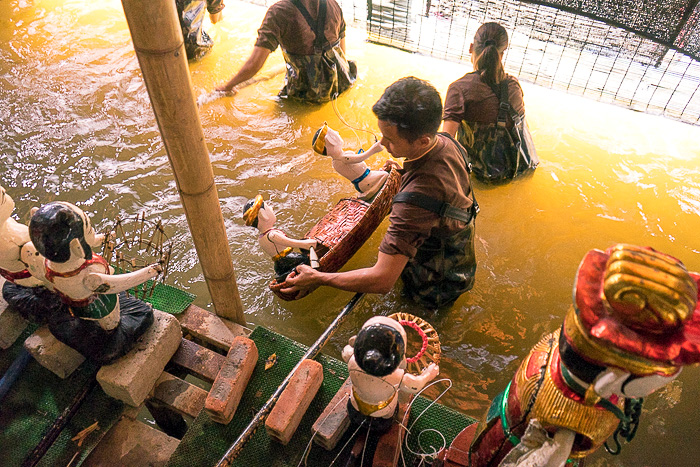

Music controls speed, keeps rhythm, leads movements, creates an atmosphere with traditional rhythms playing the main role, water puppet music often uses Cheo tunes or folk songs of the Northern Delta.

The success of the water puppetry mainly depends on the movement of its body, its act of acting. They manipulate each pole or pull puppets with strings arranged outside or underwater. The water puppeteer stands in the game room to control the puppet. The controller is hidden in the water, taking advantage of the power of the water, creating remote control, offering viewers many strange and unexpected things. The control machine and control techniques that create the actions of the water puppets on the stage are the key to the art of water puppetry. The puppet’s body is the part that floats to the surface to represent the character, and the base is the part that sinks under the water to keep the puppet afloat and where the controller is installed for the puppet to move. Opening the show, Uncle Teu appeared cheerful and naughty as the leader of the story. The most typical character is Uncle Teu – round body, optimistic witty smile. Wooden puppets are chiseled with their own stylized lines, then sharpened, polished, and decorated with different paint colors to enhance the lines and personality of each character. through a system of poles, strings… and supported by drums and flutes. The puppets are made of wood, performed by the control of the people behind the background. In the countryside of Vietnam, the background is covered, surrounded by flags, fans, elephants, parasols, gates… Water puppetry has different characteristics from ordinary puppetry, people use the water surface as a stage (also known as puppet house or water house) erected in the middle of a pond or lake with a balanced architecture symbolizing the roof of the house. It now is nominated to be a UNESCO’s Intangible Cultural Heritage.Uncle Teu – the typical character of water puppetry Vietnam’s water puppetry is a notable form of art performance in Vietnam and has been widely introduced to international community.

Exciting background music combined with amazing stage of living puppets and colorful flags bring audience a bustling ambiance of traditional festival in the country. To assist puppeteers in puppetry performance, there is an orchestra which plays traditional instruments such as vocals, drums, wooden bells, cymbals, horns, erhu (Chinese two-stringed fiddle), and bamboo flutes. To do this work, puppeteers have to stand in cold water for hours. Puppeteers stand all behind the screen and control puppets performing a play or a dance through a long string mechanism under water surface.

Water stages are usually built on small pool, and resemble a temple with a split-bamboo screen. Differ from other kinds of puppetry in the world that perform on ground stage, Vietnam’s water puppetry is performed on water stage. The unique feature of Vietnam’s water puppetry is its stage. “Teu” has the love of many generations of Vietnamese people and has become a symbol of water puppetry. “Teu” is a little boy that plays the role of narrator and joker, as well as represents the masses. The puppet called “Teu” usually has a plump body and lovely face. On the stage of water puppetry, there is a famous and outstanding character named “Teu”. Finally, living puppets are completed and ready for the performance. Then, those blocks will be connected in a system and painted by many colors. Logs are sophisticatedly carved to have different blocks. This kind of wood is featured with light weight and flexibility that makes it easy to control. Puppets used in water puppetry are made from a special kind of wood named “sung”. Over centuries of forming and developing, water puppetry has become typical form of art performance in the North. Vietnam's water puppetry (so-called "Mua Roi Nuoc" in Vietnamese) is an old form of puppetry that originated from wet rice civilization in the Red River Delta in Northern Vietnam during Ly Dynasty (1010 - 1225).


 0 kommentar(er)
0 kommentar(er)
